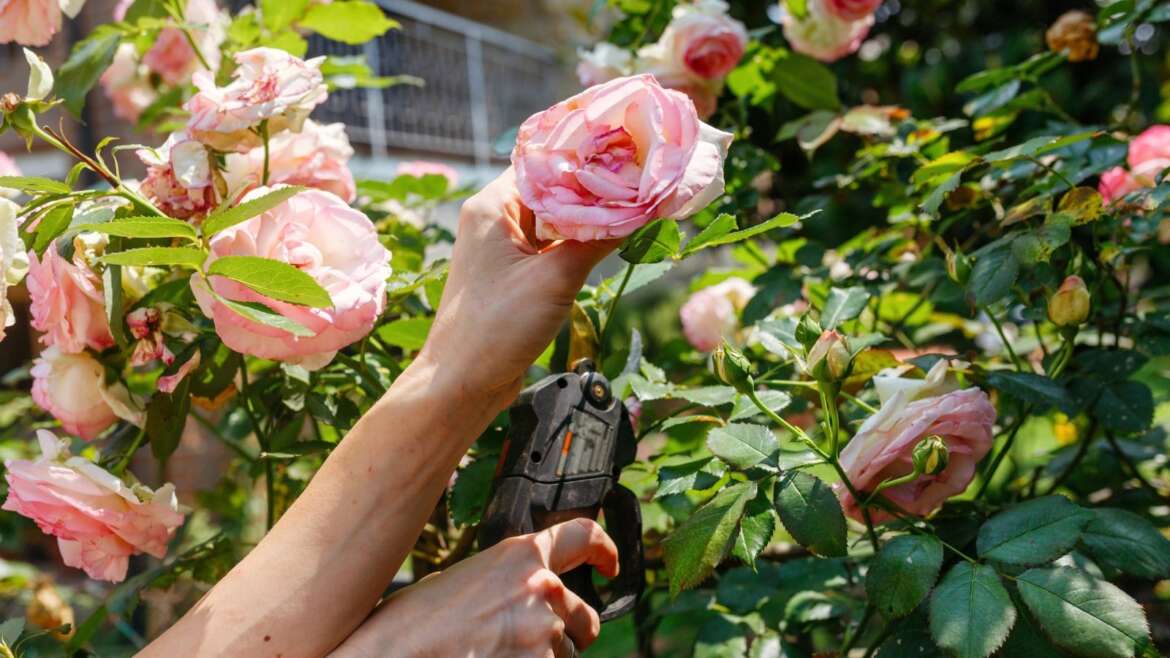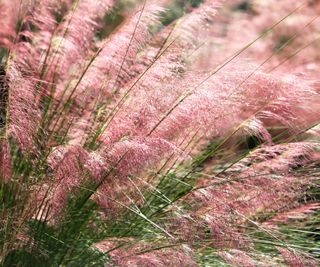With the proper care, roses are long-lived garden specimens with multi-season appeal. They’re relatively low-maintenance growers, but they benefit from simple pruning techniques for best health.
Modern hybrids and reblooming varieties may need only minimal pruning and trimming, while climbers, ramblers, and vigorous shrub roses tolerate heavier cuts for overall vigor. All benefit from the removal of dead, diseased, damaged, and crossing canes.
Enjoy them for years to come by practicing basic pruning guidelines. Avoiding common mistakes makes pruning easy and promotes the best growth and flowering for these garden sentinels. Remember that these are resilient plants that will likely rebound from any missteps.
Benefits of Rose Pruning
Pruning roses isn’t complicated, but following a few fundamentals helps them by:
- Improving form and growth habit
- Preventing diseases from spreading among plants
- Halting die back
- Increasing airflow among stems and leaves for plant vigor
- Improving flowering and encouraging new growth
- Untangling climbers, ramblers, and shrub-types
Pruning at the Wrong Time
Timing and technique are crucial for successful rose pruning practices.
Pruning at the wrong growth stage or in less-than-ideal seasonal conditions is a common mistake. The proper time to prune established roses depends on the type of rose. Single-flush roses and climbers that bloom on old wood benefit from light pruning of whippy stems in fall, after flowers fade, so that new buds set. Heavy pruning, especially in repeat-blooming selections, is best in late winter or early spring to make way for new growth and buds.
Roses are ready for pruning when new growth and buds emerge with the onset of warming temperatures. This varies depending on climate, but around Valentine’s Day is a good marker to check roses for pruning. Waiting until forsythia blooms in your area is a good indicator!
Pruning heavily in the heat of summer and during the active growing season removes new growth responsible for the plant’s energy absorption. Severe pruning then depletes energy from the plant and stresses older, woody canes. High heat and dry or humid conditions lead to further plant stress.
Limit summer pruning to removing damaged, diseased, or dead canes. This removal is an activity for any time of the year and benefits the plants by preventing the spread of common diseases like black spot and powdery mildew.
To prune declining or dead canes, cut them back to the first section of healthy, green growth. Dead canes will be brown and brittle, while healthy stems are green or white and pithy.
There are exceptions to the seasonal pruning guidelines – prune out lateral shoots of rambling or climbing varieties any time of year. These are the suckering shoots and not the primary horizontal canes to foster. For any rose, cut out weak or spindly shoots and any suckers, especially on the interior of plants.
Roses should be at least three years old before pruning. Young plants are busy producing tender new growth and developing roots.
If they become unruly or untidy with the season’s robust growth, tie canes to a trellis or stake rather than pruning in summer conditions. Deadhead as desired to promote flowering and a groomed look.
Pruning For the Wrong Type
 Proper pruning enhances rose health and promotes abundant flowering each season.
Proper pruning enhances rose health and promotes abundant flowering each season.
Climbers, with their vigorous growth habit, become tangled and crowded without proper thinning, leading to decreased flowering. In the fall, cut back or tie long stems that are likely to whip around in wind or sustain damage over the winter. In late fall and into winter, cut out the oldest canes if plants become crowded on the interior, training new canes to take their place as primaries.
Ramblers are similar to climbers but often bloom in a single flush once a season. Prune ramblers in late summer, early fall, and into winter, after the flowers and rosehips fade. Selectively thin canes to allow room for new growth and airflow. Shorten plants and encourage new growth by cutting one in three of the oldest woody stems to the ground.
Shrubs are vigorous growers with stately natural forms that often arch or grow dense and leafy. Light pruning of crossing or rubbing canes, weak stems, or dead/diseased canes is usually enough to maintain their habit and health. Selectively cut older, woody canes to the ground if they become unproductive to encourage new growth to take their place.
Single-season flowering shrub roses take pruning in the fall, while repeat-blooming shrubs do best with late winter cutback. Repeat bloomers can be cut by one-third to promote new growth.
Hybrid teas and floribundas should be pruned in late winter and early spring. Reduce established plants by one-third to maintain the current size in the growing season. Aim for a rounded form for the best aesthetic.
Deadheading Too Early
 To encourage continuous blooms, prune spent roses carefully and timely.
To encourage continuous blooms, prune spent roses carefully and timely.
Deadheading is a common practice to promote recurrent flowering and tidy up the plant’s appearance as blooms fade. To deadhead roses properly, clip individual flower stems as petals wither or cut the entire cluster of spent blooms down to the first leaflet. Reblooming varieties will direct energy into producing more flowers.
The catch for deadheading is that removing spent blooms also eliminates the possibility of rosehips. Some species don’t bear showy hips, but others produce fruits in reds, oranges, yellows, and even purples. Rosehips last well into fall and even winter for added ornamental interest. Birds and foraging wildlife use rosehips as a food source.
If your rose blooms once a season with a single flush of flowers, deadheading too early prevents plants from going to seed (i.e., producing hips). Let the blooms linger for the hips to set and develop later in the season.
Repeat bloomers benefit from deadheading in early and mid-summer. Removing spent flowers prevents plants from going to seed and instead continues to flower. Stop deadheading in late summer so that hip-bearing roses have time to fruit for the cool season, and six to eight weeks before the anticipated frost date to allow them to enter dormancy rather than encourage new blooms.
 Use sharp, clean tools and sanitize between plants.
Use sharp, clean tools and sanitize between plants.
Wear good gloves and use sharp, clean bypass pruning shears or long-handled loppers for woody or hard-to-reach stems. Bypass pruners, as opposed to anvil pruners, use blades that pass through stems like scissors for precise cuts. Sharp tool blades ensure clean cuts, free of shredding or tearing stem tissues, which can cause weakness and susceptibility to pests and diseases.
Since roses transmit common diseases, using sterile tools when moving between plants is best. Clean pruners and loppers with sanitizers to kill bacteria, fungus, and viruses that may hop from plant to plant through tool usage. First, wipe away any residues on the blade. After sanitizing, allow tools to dry before using.
To sanitize hand tools, chemical disinfectants include:
- Rubbing alcohol, 70% or higher concentration of isopropyl alcohol
- All-purpose household cleaner like LysolⓇ with 0.1% alkyl dimethyl benzyl ammonium saccharinate
- Bleach and water in a spray bottle or bucket – 1 part bleach to nine parts water
Making the Wrong Cut
 Prune cleanly at an angle just above a bud.
Prune cleanly at an angle just above a bud.
Now that our tools are sharp and clean, making the cut becomes much easier. Simply clip stems and canes at a 45-degree angle at one-eighth to one-quarter-inch above a bud or leaf node (where leaflets meet the stem). Angle the cut downward in the direction opposite the bud.
Cutting stems on an angle purportedly helps water to run off surface cuts rather than collecting on the stem and bud, leading to potential diseases. This is beneficial for any cut when it comes to pruning, even in deadheading spent blooms.
This cutting advice is pass-along rose pruning wisdom that’s not necessarily proven, as any clean cut gets the job done. It certainly can’t hurt!
Leaving Debris In Place
 Dispose of pruned rose debris to prevent disease spread effectively.
Dispose of pruned rose debris to prevent disease spread effectively.
In pruning, especially when removing diseased canes, leaves and stems with black spot may drop. Black spot is a common fungal infection that spreads easily. For the best cultural conditions, it’s important to remove the canes and any fallen leaves from around plants (this is good practice year-round). Removing the material gets rid of diseased parts and prevents future spread. It minimizes damp conditions among unhealthy leaves at the soil level.
Since rose debris may carry diseases, it’s best to dispose of cuttings and leaves rather than add them to the compost pile. Spores proliferate and spread to other garden plants through the compost. Bag up debris to throw away or burn it.
Final Thoughts
A little pruning goes a long way. Removing diseased, weather-damaged, and declining canes allows new, healthy growth to take their place. Pruning out crossing canes and opening plant interiors improves air circulation and plant form and directs energy to the most vigorous canes. Cutting back old, woody stems reduces plant size and density, creating space for new growth.
Roses are forgiving plants. Their beauty belies their rugged nature. Follow best practices to avoid rose pruning mistakes, and gorgeous blooms will be your reward this season and beyond.




